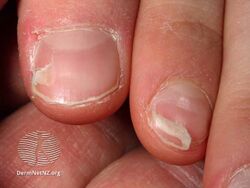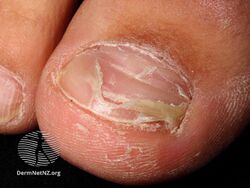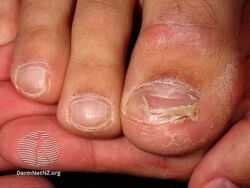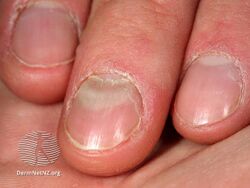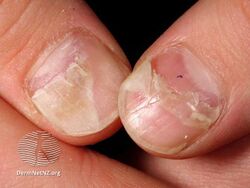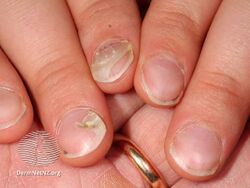Onychomadesis
| Onychomadesis | |
|---|---|
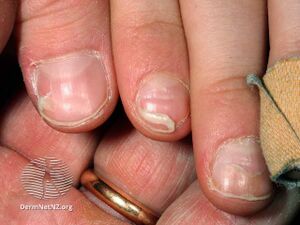 | |
| Onychomadesis following hand foot and mouth disease | |
| Specialty | Dermatology |
| Symptoms | Loss of one or more nails[1] |
| Causes | Trauma, viral illness, some medicines[1] |
| Diagnostic method | Appearance[1] |
| Treatment | Reassurance[1] |
| Prognosis | Good[1] |
Onychomadesis is a spontaneous loss of nail.[1] It typically occurs in one nail when due to trauma, or in multiple nails following a viral illness or some medicines.[1] The nail generally totally detaches from the base with a new nail appearing at the same time.[2]
It is caused by the temporary arrest of the function of the nail matrix.[3] The condition resolves without any specific treatment.[1]
Appearance
-
Onychomadesis following hand foot and mouth disease
-
Onychomadesis following hand foot and mouth disease
-
Onychomadesis following hand foot and mouth disease
-
Onychomadesis following hand foot and mouth disease
-
Onychomadesis following hand foot and mouth disease
-
Onychomadesis following hand foot and mouth disease
Cause
It is a periodic idiopathic shedding of the nails beginning at the proximal end, caused by the temporary arrest of the function of the nail matrix.[1]
Outcome
The condition generally resolves without complication.[1]
See also
References
- ↑ 1.0 1.1 1.2 1.3 1.4 1.5 1.6 1.7 1.8 1.9 Bellet, Jane Sanders (2021). "Paediatric nail disorders". In Lipner, Shari (ed.). Nail Disorders: Diagnosis and Management, An Issue of Dermatologic Clinics. Philadelphia: Elsevier. p. 232. ISBN 978-0-323-70923-1. Archived from the original on 2022-05-08. Retrieved 2023-08-03.
- ↑ Berker, David de (2019). "20. Diseases of the nails". In Morris-Jones, Rachael (ed.). ABC of Dermatology (7th ed.). Hoboken: Wiley Blackwell. p. 167. ISBN 978-1-119-48899-6. Archived from the original on 2023-08-05. Retrieved 2023-08-03.
- ↑ James, William D.; Elston, Dirk; Treat, James R.; Rosenbach, Misha A.; Neuhaus, Isaac (2020). "33. Diseases of the skin appendages". Andrews' Diseases of the Skin: Clinical Dermatology (13th ed.). Edinburgh: Elsevier. pp. 782–783. ISBN 978-0-323-54753-6. Archived from the original on 2023-04-12. Retrieved 2023-08-03.
